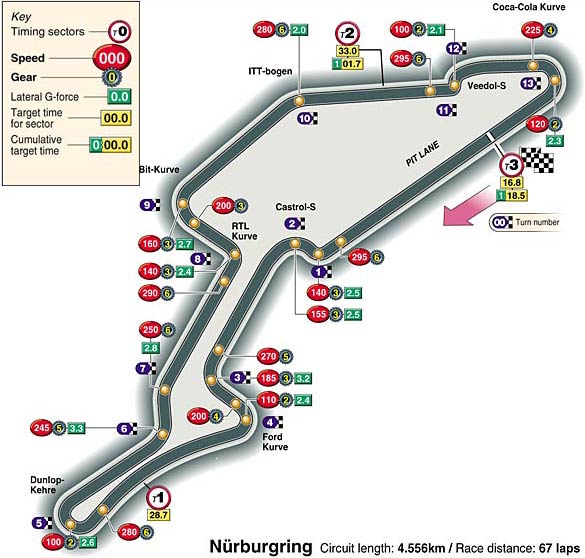|
| |||
 |
A Lap of Nurbrugring | ||
| by Paul Ryder, England | |||

A flying lap of the 4.5 km Nurburgring circuit begins at the long start/finish straight. Powering down the straight, which is the highest part of the circuit, drivers hit 300 kmph in 6th gear as they reach the first corner, a tight right followed by a slightly longer left, the Castrol-S corner.
Watching they don't slide to the left as they turn into the sharp right, getting this corner right sets up for a fast exit at 170 kmph as you enter a short straight. Reaching 270 kmph in 6th gear, drivers break for a moderate left, taken at 180 kmph before switching across to the left of the circuit for the Ford Kurve, taken even slower at 105 kmph, second gear.
The Ford Kurve leads onto a straight which sees an elevation drop as they power down towards the slowest part of the circuit. Passing the first timing sector on the way, drivers reach the Dunlop-Kehre, a hairpin surrounded by a massive spectator stadium section. Slowing to 85 kmph for the moderate hair pin, drivers play with the throttle as they attempt to find grip and set up for quick exit and run up to a sweeping left and right taken at almost full throttle, at 250 kmph. This corner is tricky and can catch one out as he reaches the crest of the hill, being on the wrong line here can see him in the gravel.
Continuing the build up of speed along another straight, drivers power down towards the RTL Kurve, a tight left taken at 150 kmph followed by a right taken at 170 kmph. Again the car has to switch from right to left between each corner, leaving no room for error. Taking the Bit-Kurve, in 3rd gear, drivers run down a big elevation drop towards the ITT-bogen corner, which is a fast sweeping right taken at 265 kmph.
Watching on the entry as the car bottoms out before continuing up a hill towards one of the most tricky parts of the circuit, the Veedol-S chicane, also passing the second timing sector. Drivers break heavy from 290 to 100 kmph as they turn sharp left then right exiting the chicane and running over the exit kurbs. A short straight follows before the final corner, the Coca-Cola Kurve, taken at 110 kmph. This corner is vital to conclude a good lap and can set up for a fast run onto the start/finish straight, completing a lap of Nurburgring.
It was used as the title of the opening round of the new World Championship at Silverstone in 1950. From then on, the title was used as an honororary title every year (apart from 1953) until 1968. As such, it flitted around the various venues, and three times it visited the Nurburgring, on each occasion marking a significant event.
The first time was when Juan Manuel Fangio won for Mercedes-Benz in 1954, Mercedes' second Grand Prix victory of the year. In 1961, it was the venue for Stirling Moss's classic defeat of the Ferraris in Rob Walker's Lotus, while seven years later, Jackie Stewart drove what was acknowledged to be one of his finest races ever when he beat Graham Hill's Lotus by over four minutes in appalling conditions. Incidentally, the record holder when it comes to European Grand Prix winners stands to Moss and Tony Brooks who both won it two and a half times - they shared the winning Vanwall at Aintree in 1957.
But in 1983, the European Grand Prix reappeared at Brands Hatch, now in its latest guise as the alternative title of a race where two Grands Prix were being held in one country. Silverstone held the British Grand Prix, Brands Hatch the European, and next year, it hosted the British Grand Prix, before having the European again the following year, when Nigel Mansell scored his first win but Alain Prost clinched the 1985 title.
A year later, the Spanish Grand Prix was at the Circuit de Catalunya while a European race was held at Jerez, near Seville, former venue for the Spanish Grand Prix itself. Michael Schumacher won, as he did the following year when the European race returned to the Nurburgring for its second visit to the new circuit. A year later, Jacques Villeneuve scored his first victory by beating Schumacher, now in a Ferrari.
The 1999 Atlas F1 European GP Review Issue
|
| Paul Ryder | © 2000 Kaizar.Com, Incorporated. |
| Send comments to: paul@f1world.com | Terms & Conditions |